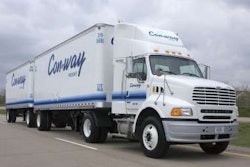Next-generation computers make directions easier
During a recent trip to Minneapolis, I climbed aboard an International CXT pickup truck owned by Xata Corp. In the driver’s seat, Tom Flies, Xata’s senior vice president of product management, was playing the role of a company driver.
After logging into the Xatanet system using a color touchscreen display, Flies entered his trip number. Only moments before, Flies had been in his office playing the role of fleet manager. He had logged into the Xatanet online fleet management system from his desktop, where he had entered the destination address for a short trip a few miles away from Xata’s headquarters.
In the driver’s seat, once Flies entered his trip number, the coordinates of the destination were sent from a server to the onboard unit and entered automatically into the truck’s onboard in-cab navigation software, ALK’s CoPilot Truck. When the truck started moving, CoPilot Truck provided spoken turn-by-turn directions, along with a graphical moving map, to the destination and back.
Increasingly, more fleets are using this type of integration between onboard computing platforms and in-cab navigation software to give drivers a seamless process to manage important trip details. Besides using navigation to acclimate drivers quickly to new routes and pickup/delivery locations, fleets can use the integration to gain more control over their vehicle routes when schedules change.
The next-generation computing platforms feature high-resolution touchscreen displays, powerful operating systems and high-speed wireless communications. For now, the major providers of onboard computing systems have narrowed their offerings to two in-cab navigation applications: CoPilot Truck and NaviGo.
ALK’s CoPilot technology has been on the market for 11 years, says Craig Fiander, vice president of marketing for ALK Technologies. Based upon the company’s PC Miler routing and mileage engine, CoPilot Truck uses GPS signals collected by onboard computers for real-time navigation.
NaviGo, an in-cab navigation service from Maptuit, uses a hybrid combination of onboard and server-based technologies to produce routes for commercial trucks. The hybrid approach makes it possible for the company to provide immediate changes to its routes in case of incidents such as road construction or weather-related road closures, says Luke Wachtel, executive vice president of sales.
Who offers what?
Qualcomm Enterprise Services (QES) has offered NaviGo on its Mobile Computing Platform for more than a year. Qualcomm integrates current trip information into the NaviGo application, including pickups, fuel stops, deliveries and other points of interest from incoming messages from the office. QES soon plans to announce the availability of in-cab navigation from two additional providers, says Norm Ellis, vice president of transportation and logistics sales and service.
From a safety and liability standpoint, QES has designed the system to allow drivers to listen to a message while the navigation application is running. The system immediately pauses the messaging application so the driver can hear any NaviGo spoken directions. When in motion, the driver cannot enter text into the navigation application in order to enter a new route.
“I believe we have really worked diligently to protect customers and drivers from incidents,” Ellis says.
PeopleNet has offered Maptuit’s NaviGo on its BLU platform since November. About 20 PeopleNet customers currently use NaviGo, says Kirsten Lester, the company’s product manager of driver services and interfaces. PeopleNet currently is working with ALK to offer CoPilot Truck, she says.
Currently, fleets that use the PeopleNet BLU platform send drivers their trip details in a text message. Drivers enter their desired destination addresses in NaviGo using a keyboard or BLU’s touchscreen display. Later this year, PeopleNet plans to integrate the trip details – customer addresses, fuel stops and other points of interest – from third-party dispatch software into NaviGo, Lester says.
DriverTech offers both NaviGo and CoPilot Truck in its DT4000 TruckPC computer. Rather than send a driver a text message with his load assignment and route, DriverTech takes that data and puts it into a separate route file. Through wireless communications, the coordinates in this route file are inserted into the navigation software onboard the unit.
“The last thing you want is the dispatcher or driver rekeying data,” says Scott Lemon, vice president of sales for DriverTech. Out of the box, the Windows XP-embedded TruckPC includes Navteq street-level map views on its display terminal. The map views allow drivers to see their current position and to scroll forward or zoom out to see roads ahead, Lemon says.
Cadec recently announced an exclusive partnership with ALK to offer CoPilot Truck in its Mobius TTS and PowerVue onboard computing platforms. Route information is downloaded automatically to CoPilot on the onboard unit for each trip. Drivers have the choice of whether or not to use navigation. They simply can toggle back and forth between Cadec and CoPilot using their touchscreen display, says Frank Moreno, Cadec’s vice president of marketing and product management.
Besides being a driver perk, navigation software offers a straightforward cost-benefit calculation, vendors say. Setting aside the customer service and safety benefits from using truck-specific routing, the primary cost justification for the software is reduction of nonrevenue or “wasted” miles. To break even, for example, a fleet would want to see a reduction of 10 miles a month, per truck, assuming it pays $10 per truck per month for navigation software and its operating cost is $1 per mile.
PeopleNet releases BLULink for custom development
PeopleNet, a provider of Internet-based and integrated onboard computing and mobile communications systems for fleet management, launched BLULink. The technology makes it easier and faster to develop custom software applications to run on PeopleNet’s BLU in-cab PC – for both customers and the company’s Tailored Solutions team, the company says. “With BLULink, we’re giving our customers a choice to help them meet their specific operational needs,” says Randy Boyles, Tailored Solutions vice president.
BLULink makes the Software Development Kit – introduced last year with the BLU platform – easier to use because it requires less training and no onsite assistance, PeopleNet says. BLULink is designed to grant customers direct access to the PeopleNet network to do their own over-the-air programming, similar to the OTAP technology that the company introduced several years ago.
The company says BLU makes engine control monitoring data, eDriver Logs information and GPS positioning data readily available for custom applications; in addition, BLU’s open software environment enables BLULink to support full data exchange with back-end systems, as well as in-cab devices that use PeopleNet’s proprietary PTP protocol. BLULink also supports BLU’s serial port so that it can interface to other serial devices such as mobile printers, according to the company.
PeopleNet also announced record revenue and subscriber growth in 2008, with more than 100 new fleets signed.
Qualcomm announces MCP200 Series
Qualcomm Inc., a provider of business-to-business wireless enterprise applications and services, announced its new Mobile Computing Platform 200 Series (MCP200). An addition to the Qualcomm Mobile Computing Platform product line originally launched in September 2006, the MCP200 is designed to deliver an expanded set of OmniVision Transportation Services, adding Wi-Fi, in-cab video training, Internet access and multimode capability.
The MCP200 Series will enable fleets to effectively transform their cabs into mobile operations centers, the company says. For example, drivers now can access training, targeted customer information and relevant back-office data such as payroll information from the cab.
“Carriers can take advantage of the MCP200’s power capabilities to grow their revenues and provide a higher level of customer service,” says Norm Ellis, vice president of transportation and logistics sales and service for Qualcomm Enterprise Services. The MCP200 will be available this summer.
Qualcomm also announced that its first MCP, launched in 2006 as OmniVision, has reached 33,000 active units with nearly 300 carriers.














